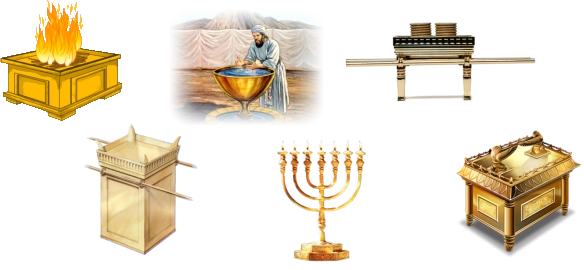
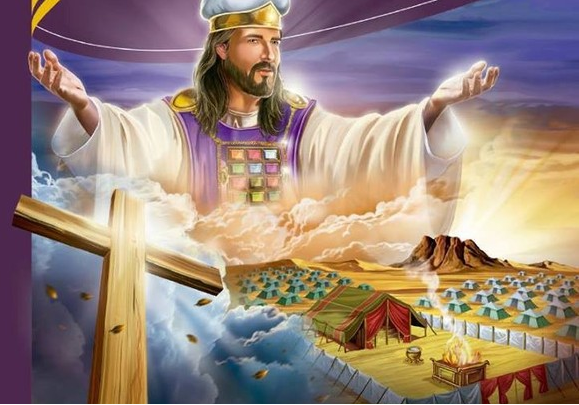
God ordered the Desert Sanctuary to be built to give his people an object lesson in spiritual and eternal truths. The I “will dwell in their midst” of Exodus 25:8 contains the word “dwell”, which has been translated from the Hebrew word shakan, which, although it is translated “dwell”, has an even deeper connotation, since it communicates to us the idea that this “dwelling” is that of a neighbor, someone who wants to be close and enjoy our friendship.
The Sanctuary of the desert was the sacred enclosure where God lived in the midst of his people, but obviously this is a symbol of a higher truth: rather than in material temples made by man (Acts 17:24), God wants to dwell in the temple of the human soul (1 Cor. 3:16, 17) to fill it with the glory of the Holy Spirit, who is the personal representative of the Lord Jesus Christ, because it is "Christ in you, the hope of glory" (Col 1:27) .
“No earthly building could represent the greatness and glory of the heavenly temple, the abode of the King of kings. . . However, the important truths about the heavenly sanctuary and the great work that is done there for the redemption of man were to be taught through the earthly sanctuary and its services” (PP 371).
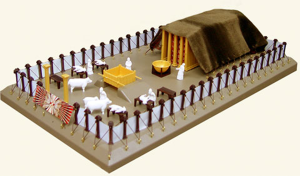
The Sanctuary was built based on a scheme that contemplates three clearly discernible sections: the Atrium, the Holy Place (qódesh) and the Holy of Holies (qódesh qodashim).
What was in each part?
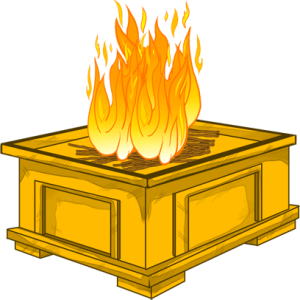
What did each piece of furniture represent?
1- Altar of the holocausts.
It is called "altar" (Exo. 28:43; 29:12, 44; 30:20). The Hebrew word used here (Myzheaj) means "place of sacrifice." It is also called the "altar of burnt offerings" (Ex. 30:28; 31:9; 35:16; 38:1; 40:6, 10, 29). The word "holocaust" does not express in our language all the richness of content it has in Hebrew. It comes from the original 'olah,' which means 'that which ascends,' and can communicate the idea of total and unreserved surrender in "soft smell" to God, who in turn accepts the consecration offering by sending the "divine fire" to consume it (Lev. 9:24).
Wood and bronze were the materials used to build the altar (Exo. 27:1-8; 38:1-7), and its measurements were: five cubits long by five wide and three high (the elbow measured about half a meter).
On the altar one sees the goodness and severity of God: goodness toward us sinners, and severity toward the vicarious victim who bears our sins (Rom. 11:22). The position of the altar as the first piece of furniture in the court suggests that there is no access to God except through a sacrifice. The altar symbolically anticipates the Gospel message that Jesus is "the Way, and the Truth, and the Life," and that "no one comes to the Father" except through Him (John). 14:6).
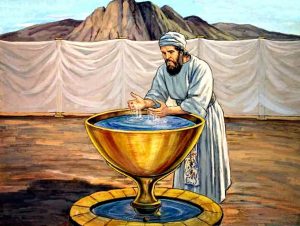
2- The Brazen Laver.
We have no biblical information as to the size and shape of the brazen laver, but we do know that it was built using the bronze mirrors of "the women who watched over the door of the tabernacle" (Ex. 38:8). Bronze seems to represent the firmness, solidity, and incorruptibility of God's commands . As the believer sees the deformities of his character reflected in the mirror of God—which corresponds to his Word and commandments (Sant. 1:23-25)-, the divine power penetrates into his life and, enlivening his consciousness, leads him to the feet of the cross, where our Lord transforms us " by the washing of the regeneration and by renewal in the Holy Spirit" (Titus 3:5).
The priest of the ancient dispensation could draw near to God by water and blood. On the altar of burnt offerings the blood speaks of the justice of God, and of the justification that is vicariously imputed to the believer. In the water wash, the next step, that of sanctification, is indicated. Through these two symbols it is clearly expressed that Christ is made to us by God "justification, sanctification and redemption" (1 Cor. 1:30). Jesus came in order to be the source of purity for man. Through Christ, the sinner becomes part of God's people. And this is possible because the Savior came "by water and blood" (1 John 5:6).
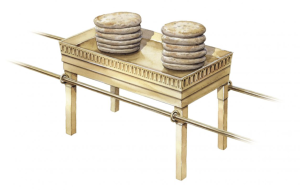
3- The Table of Breads.
It was built of acacia wood and covered entirely with gold. It measured two cubits long by one wide and one and a half high. According to biblical indications, the table had a double crown (cornice) of gold that surrounded it throughout its contour. Symbology authorizes us to suppose that this double crown points to Jesus who, as "King and Priest" (Heb. 7), he was "crowned with glory and honor" (Heb. 2:9). On the other hand, acacia wood symbolizes the humanity of our Lord, and gold, his divinity.
Twelve loaves of bread were placed on this special table in two piles, and incense was placed on each pile (Lev. 24:7). This represents the spiritual food that Christ gives us, which is constantly renewed, just as the loaves of the Sanctuary table were renewed every week.
The "sacred bread" is a "continuous bread" or "perpetual" (Num. 4:7), renewed every Saturday without interruption. The one who renews it every Sabbath establishes an intimate relationship between spiritual rest (Gen. 2:1-3) and the joy of Christ's presence in us, which makes the Sabbath a foretaste of eternity.
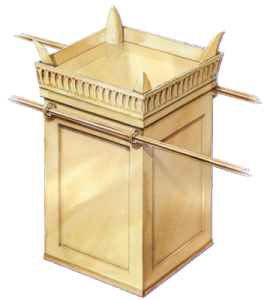
4- The Altar of the Incense.
The Sanctuary of the desert Had Of Altars: the of the Holocausts and the altar of the incense. This last Was placed in the Place Holy forehead to the veil What Separated the Place Holy of the Holy (Éxo. 40:26). Was constructed with wood of acacia y give it to you coated totally of gold.
The incense altar was two cubits high, and its square deck had one elbow on its side.
.The finished one corona of gold and in every corner Had one horn (Exo. 37:25- 27). Envelope the horns herself spread the blood of the expiation when the Priest o the congregation pecaban y also in the Day of the Atonement (Leviticus) 4:7, 18; 16:18). The incense What the Priest Placed envelope the embers Participated of Certain characteristics Special (Exo. 30:34-38), and Should Offer Of times to the day continually (Exo. 30:7-8), in Ceremonies Stipulated.
The burning of incense was the most sacred task of all that the priest could perform. It gave him the opportunity to reach the veil, behind which the ark of the covenant hid. In zechariah's time it was interpreted as a superlative favor on god's part that a priest could officiate in the burning of incense; it was not conceivable that he would do it a second time.
The burning of the incense coincided with the time when the people raised their prayers. David said, "Lift up my prayer before you like incense" (Ps. 141:2), and his thought coincides with that recorded in Revelation: "And by the hand of the angel he went up to the the smoke of incense with the prayers of the saints is present in God" (Rev. 8:4).
The altar of burnt offerings and their sacrifices communicate to us a fundamental truth: in Christ there is perpetual reconciliation, while the altar of incense, where perfume is offered. Holy, it teaches that Christ intercedes perpetually. The altar of incense represents Christ as the effective means through which we raise our praise to God. Therefore, the two altars must be studied and understood as the multifaceted expression of an essential truth: sacrifice is the prelude to praise (Heb. 13:13-15).
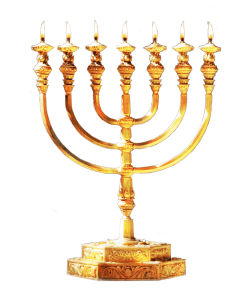
5- The Candelabrum (heb. Menorah).
The Writing No Of the measurement (Éxo. 25:31- 40), but Yes Advises What herself the Delivered a Bezaleel one talent of gold and is the Indicated What Do one candelabrum Using fire and hammer in your construction. The artifact Resulted be the more elaborate and beautiful of all his furniture.
The chandelier, built of pure gold, had a base and stem, and from the latter came out symmetrically three arms of each
side, those who, added to the center, completed the number seven of perfection. Each arm itself consisted of three chalices like an almond blossom, with their balloons and lilies. The seven arms ended in seven lamps, which were to remain lit day and night (Exo. 25:31-40; 27:20; 37:17-24; Lev. 24:2, 3).
In addition to its aesthetic quality for the beautification of the Holy Place, the lamp was there essentially to illuminate. The light was projected in three directions:
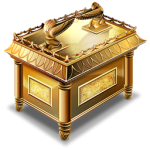
6- The Ark of the Covenant.
The Most Holy Place, where the Ark was, was separated from the Holy Place by a curtain called "the veil" (Heb. 9:3). This veil was ten cubits high, and the material used was crooked linen, blue, purple and crimson. It had embroidered cherub ornaments and was suspended from gold brackets. The four pillars or columns that supported the structure of the curtain were made of acacia wood and were clad in gold, and the bases were made of silver (Ex . 26:31-33).
According to the biblical record, the Ark of the Covenant was the only piece of furniture inside the Holy of Holies. It was built of acacia wood and covered with gold inside and out. It measured two and a half elbows long by one and a half wide. The cover or lid called the mercy seat, was made of pure gold and had two cherubs on top, which formed with the mercy seat a single piece.
The mercy seat was surrounded by a cornice also made of gold.
The cherubim were located, one at one end, and the other at the other end. " In one piece with the mercy seat you will make the cherubs at both ends. And the cherubim will spread above the wings, covering with their wings the mercy seat; their faces in front of each other, looking at the mercy seat at the faces of the cherubim" (Ex. 25:18-20).
The Ark was the receptacle of the tablets of the Law (Deut. 9:9, 11, 15; 10:5), who in turn were witnesses to the covenant That God had made with His people. Two other items that were placed inside the Ark were Aaron's rod that greened and an urn with manna (Heb. 9:4; Ex. 16:33). On one side of the Ark was the scroll containing the ceremonial laws (Deut. 31:25, 26).
This sacred furniture era symbol of the throne of God (1 Sam. 4:3-7), the place privileged where God Chose manifest his presence Perpetual in middle of his village (Ex. 25:21, 22).
The Hebrew word kappóreth, which carries implicitly the idea of "covering", was translated as hilasterion in the Greek version of the LXX, as propitiatorium in the Latin Vulgate, and as a "mercy seat" in our language.
In the New Testament Jesus takes the place of the temple (John 2:19-22) and the Ark, because He Himself is the only place on earth where God is present in his fullness (Col. 2:9) and consequently becomes the instrument of Omnipotence to redeem the world (2 Cor. 5:19). Jesus is the only hilasterion (John 3:16), the only propitiation or atoning offering (Rom. 3:25) of the eternal covenant, for in Christ the unique sprinkling that takes away the sins of the world has been made (Heb. 9:12, 22-28).
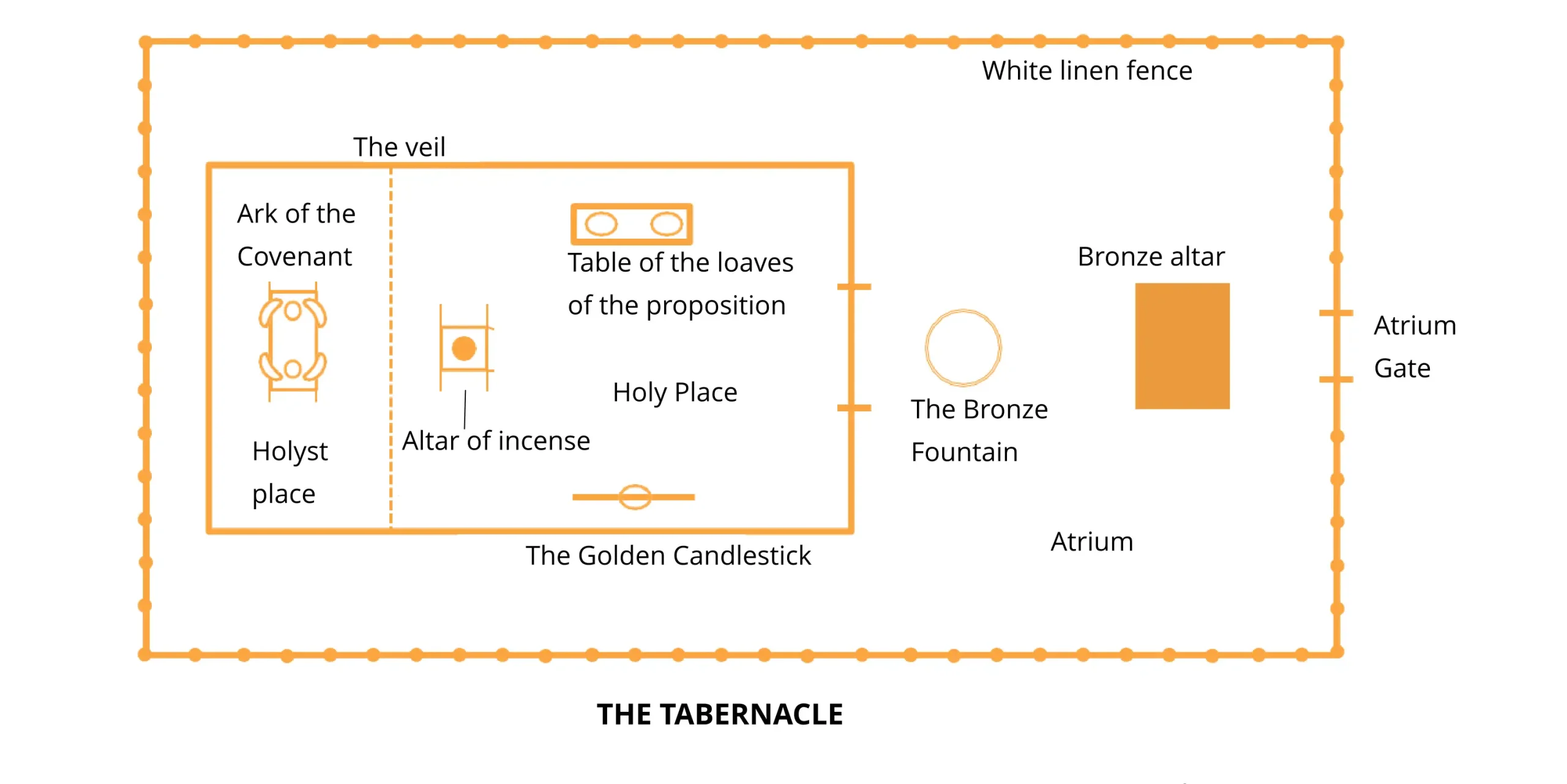
WEB & SEO: 1Energy1 Inc @ All rights reserved.